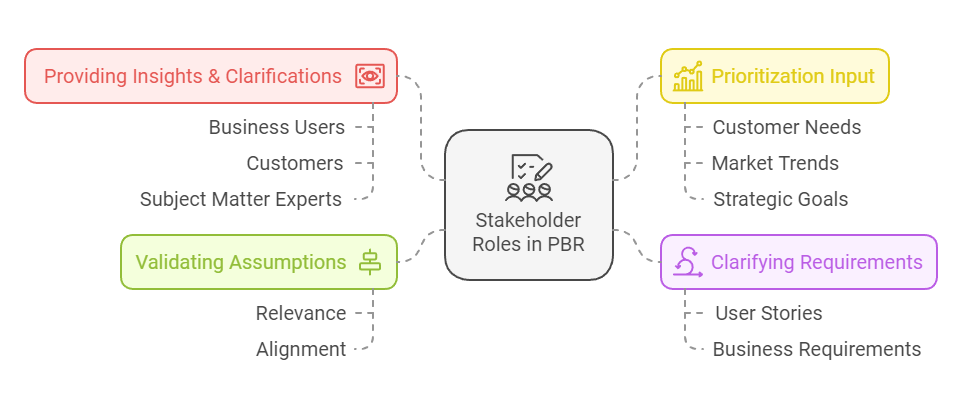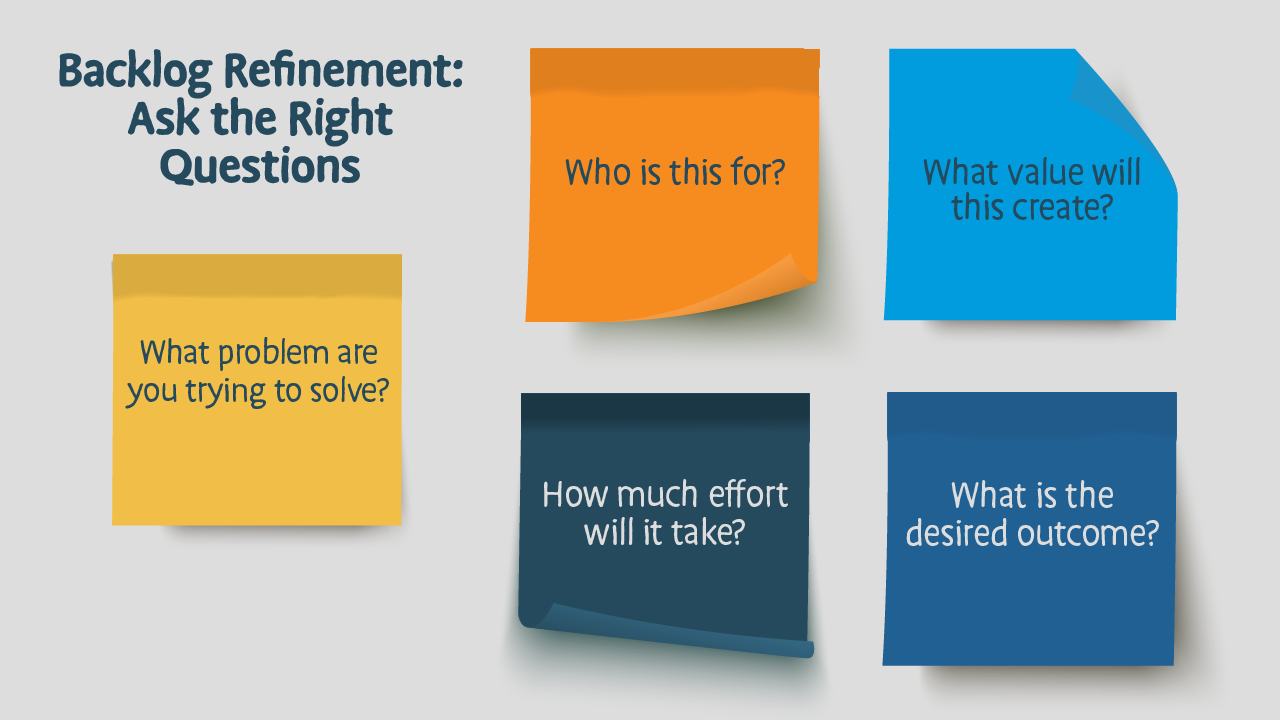Product Backlog refinement is the act of breaking down and further defining Product Backlog items into smaller more precise items. This is an ongoing activity to add details, such as a description,order, and size. Attributes often vary with the domain of work ~ The scrum Guide 2024
Introduction
Product Backlog: It is an emergent, ordered list of what is needed to improve the product. It is the single source of work undertaken by the scrum Team.
Product Backlog Refinement(PBR): Also known as Backlog Grooming is the act of breaking down and further defining Product Backlog items into smaller more precise items. Scrum teams can ensure that they are well-prepared for future work, ultimately leading to more effective Sprint Planning and execution.

NOTE
An agile scrum team can have only one product backlog. Hence product backlog is the input to the backlog refinement session. Product backlog is derived from Objectives of Epic/Sub epic of the current PI or organizational goals.
Components of the product backlog
Product backlog consists of many items such as
New Features derived from Organizational Goal
Enhancements
Epics / sub epics(objectives) related items
Bug fix
Technical debt
Spikes : It is a research task used when a team needs to investigate an unknown or unclear technical issue or requirement. This type of item helps to reduce uncertainty and risk.
Acceptance criteriaDefinition of Done (DoD)ItemsNon-Functional Requirements (NFR)'s like performance ,scalability ,compliance etc
Key Roles and Responsibilities
Product owner : Ensures backlog items are well-prepared and aligned with the product vision and goals. Gathers feedback and makes necessary adjustments to the backlog based on the PBR results in optimized realistic backlog.
Development team (Scrum team) : Active participation is must and team provides input on technical feasibility, risks, and effort estimation. Clarifies doubts and ensures good understanding of requirements.
Scrum master : Facilitates the meeting, ensuring it remains focused ,productive and time boxed. Encourages collaboration and resolves conflicts if any arise.
And the stakeholders(optional) : Below diagram summarizes the responsibilities of a stakeholder in PBR.

NOTE
To keep the backlog useful and actionable, the Product Owner is essential in promoting communication between the team and stakeholders. Product owner is in charge of the product backlog, whereas scrum teams or cross-functional teams are in charge of discussing and implementing it.
Ideal Timing for PBR
PBR is an ongoing activity in scrum, but it doesn't have a fixed schedule. Instead, it should happen regularly throughout the sprint to ensure that the Product Backlog remains up-to-date, well-defined, and ready for future sprints.
During the Sprint: PBR is most effective when performed throughout the sprint rather than at the finish. scrum teams frequently set aside particular time frames (such as 5-10% of the team's capacity) during each sprint to work on revising the backlog. This helps to ensure that the backlog is always available, avoiding last-minute work before the sprint planning meeting.
PBR is a
continual activity, not a one-time event. It occurs on a constant basis, ideally throughout the sprint, allowing the team to regularly refine the Product Backlog in preparation for future work.Before sprint planning: The Product Backlog should be sufficiently developed to allow the team to select items with clear, well-understood needs and adequate detail. You want to have enough backlog items prepared for sprint Planning, but not so many that they cause confusion or bottlenecks during the meeting.
As a rule of thumb:
- At least one sprint forward should be developed and prioritized sufficiently to be reviewed during the next sprint Planning session.
- Aim to have about 80% of the backlog items for the next sprint ready for the team to work on.
Some scrum teams do regular refinement sessions, which are informal gatherings or working sessions. These normally occur once or twice per sprint, and the timing
As Part of Sprint Review/Retrospective Preparation : In some cases, insights received from a sprint Review e.g., stakeholder comments, product demos or a sprint Retrospective (e.g., insights into team process improvements) might have an impact on the backlog. If this is the case, modifications and enhancements may occur shortly after the events.
When Needed Based on Changes or Feedback : Changes in Business Needs , new insight(risks ,regulations).
TIP
Typically, 1–2 hours of refinement per week (depending on the length of the sprint) is recommended. This means if you're running a two-week Sprint, you might set aside 1–2 hours per week for PBR.
PBR is a continual activity, not a one-time event. It occurs on a constant basis, ideally throughout the sprint, allowing the team to regularly refine the Product Backlog in preparation for future work.
Procedure for running PBR session
PBR session should help improve the clarity, details, and estimation of backlog items to ensure that the team is prepared to select items for the next sprint. you can find more about feature prioritization here.
Here’s how a Product Backlog Refinement session should typically be conducted:
- Preparation Before the session
- Product Owner (PO) should prepare by reviewing the backlog and identifying items that need clarification, elaboration, or refinement. These items should be prioritized based on the product roadmap, business goals, and stakeholder feedback.
- Development Team should review the backlog items in advance (if possible) to have some context, and be ready to provide feedback on feasibility, dependencies, and estimation.
- Scrum Master (SM) should ensure that the meeting will run smoothly by keeping the focus on refinement (not design or implementation), keeping it time-boxed, and facilitating the discussion.
- Agenda for the Session
Start with goal and its progress: Product Owner briefly explains the objectives ,then the goals/purpose of the session i.e clarify and prioritize next sprint's scope
Review Priority Items
- Focus on high-priority backlog items likely to be included in the next sprint.
- Discuss each item to ensure it meets the Definition of Ready (DoR) criteria.
- Clear description of each user story is must.
- Acceptance criteria defined if possible.
- Feasibility (dependencies, risks).
- Estimated (story points or time-based is optional).
Break down larger items
- Decompose epics or large stories into smaller, actionable user stories.
Discuss Dependencies and Risks
- Identify cross-team dependencies or potential risks.
- Discuss mitigation or contingency plans.
PO should
Reprioritizeif needed- Adjust priorities based on team feedback, capacity, or new insights based on discussion and risks.
Best practices
Time-boxing: Keep the session short, focused, and productive. Avoid turning it into a design session.
Active Participation: Encourage the Development Team to participate actively by asking questions, offering estimates, and helping break down items.
Focus on Clarity: The goal is to ensure that items are clear, feasible, and valuable. If something is too unclear or ambiguous, the Product Owner should provide further clarification or break it down into smaller pieces.
Avoid Over-Refinement: Don’t spend too much time on backlog items that are too far in the future. Focus on the next sprint and the items that will soon be worked on.
Focus on Collaboration: Ensure open communication where everyone’s perspective is valued.
Involve the Right People: Avoid unnecessary attendees focus on the Product Owner, developers, and sometimes stakeholders for specific items.
Regular Sessions: Hold regular, predictable refinement sessions to avoid a backlog that is too large or poorly defined as you approach sprint Planning.
Outcomes of a Successful Refinement Session
- Backlog items are clear, detailed, and prioritized.
- Large items are broken down into smaller stories.
- Acceptance criteria and dependencies are identified.
- Effort estimates are in place(if possible).
- The team feels confident about the upcoming sprint's scope.
Example
User Story: Add Multi-Factor Authentication (MFA)Description: As a user, I want to enable MFA so that my account is protected even if my password is compromised.
Discussion:
PO: Explains the rising demand for enhanced security due to phishing attacks.
Team:
- Recommends using Time-based One-Time Passwords (TOTP) through apps like Google Authenticator.
- Suggests email or SMS as backup options for generating OTPs.
- Flags concerns about additional user friction and proposes making MFA optional.
Outcome:
- Tasks:
- Integrate TOTP generation and validation.
- Add SMS and email OTP fallback options.
- Update settings screen to enable/disable MFA.
- Conduct usability testing for MFA workflows.
- Estimated effort(optional): 8 story points.
- Tasks:
Description: As a user, I want clear error messages during login failures so that I can fix issues and access my account.
Discussion:
- PO: Highlights user complaints about generic error messages like "Login failed."
- Team:
- Proposes categorizing errors into "Incorrect password," "Account locked," and "Network issues."
- Suggests logging errors for better debugging and analytics.
- Outcome:
- Tasks:
- Audit current login error messages.
- Map error codes to detailed messages.
- Implement localization for error messages.
- Log errors for analytics.
- Estimated effort: 5 story points.
- Tasks:
Risks and Dependencies:
- Compatibility testing across different devices and OS versions is identified as a potential bottleneck.
- Dependency on SMS gateway for MFA fallback.
Outcomes of the Session:
- The backlog items are clarified and refined with detailed tasks.
- Dependencies and risks are documented for follow-up.
- Biometric login is marked as high-priority and selected for the next sprint.
- MFA is scheduled for phased implementation.

Conclusion
Successful refinement sessions result in a well-prepared and confident team for the upcoming sprint.Product Backlog refinement is a crucial ongoing process that ensures the Product Backlog remains well-defined and prioritized, facilitating effective sprint planning and execution.
